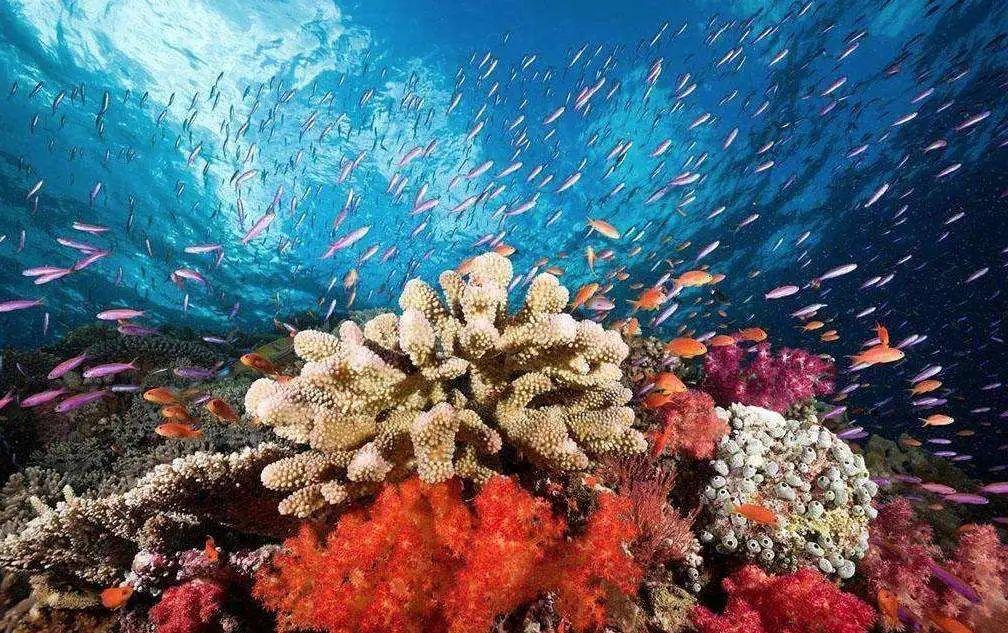海洋酸化是指由于海洋吸收、释放大气中过量二氧化碳(CO2)使海水正在逐渐变酸。自工业革命以来,海洋大约吸收了人类向大气排放CO2中的1/3,海水pH值下降了0.1。随着大气中CO2体积分数持续增高,海洋吸收CO2的量也在不断增加,最终改变了海洋自身碳酸盐的化学平衡,使依赖于化学环境稳定性的多种海洋生物乃至生态系统面临巨大威胁。随着海洋酸化的加速,影响对人类健康至关重要的资源的数量和质量,人类健康问题日益明显。
Ocean acidification refers to the gradual acidification of seawater due to the absorption and release of excess carbon dioxide (CO2) from the atmosphere. Since the industrial revolution, the oceans have absorbed approximately 1/3 of human emissions of CO2 into the atmosphere, and the pH of seawater has dropped by 0.1. As the volume of CO2 in the atmosphere continues to increase, the amount of CO2 absorbed by the ocean is also increasing, ultimately altering the chemical balance of the ocean’s own carbonates and putting at risk a wide range of marine organisms and ecosystems that depend on the stability of the chemical environment. As ocean acidification accelerates, the quantity and quality of resources vital to human health are affected and human health concerns become increasingly apparent.
海洋酸化发生机制
Mechanisms of ocean acidification
海洋酸化的发生主要体现在海水无机碳循环体系的变化,该体系包括气态二氧化碳(CO2(g))、二氧化碳水合物(CO2(aq))、碳酸氢根离子(HCO3-)和碳酸根离子(CO32-),反应平衡如下:
Ocean acidification occurs mainly through changes in the seawater inorganic carbon cycle system, which consists of CO2 (g), CO2 (aq), HCO3- and CO32-. The reaction balance formula is as follows:
CO2(g) ⇌ CO2 (ag)
CO2 (ag) + H2O ⇌ HCO3- + H+
HCO3- ⇌ CO32- + H+
无机碳循环是控制海水pH值和维持海洋化学平衡的一个重要方面。当二氧化碳溶解在海水中,形成碳酸(HCO3-),大部分的碳酸分解成氢离子(H+)和碳酸氢盐离子(HCO3-)。向海水中加入二氧化碳的净效应是,随着海洋表层二氧化碳浓度的增加,改变了海洋原有的化学平衡,碳酸、氢离子和碳酸氢盐离子的浓度迅速增加,从而影响海水的化学状态。
The inorganic carbon cycle is an important aspect of controlling the pH of seawater and maintaining the chemical balance of the ocean. When CO2 dissolves in seawater, HCO3- is formed and most of it decomposes into H+ and HCO3-. The net effect of adding CO2 to seawater is that as the concentration of CO2 increases in the surface layer of the ocean, the original chemical balance of the ocean is altered and the concentration of HCO3-, H+ and HCO3- increases rapidly, thus affecting the chemical state of seawater.
海洋酸化对海洋物种的影响
Effects of ocean acidification on marine species
从全球和历史上看,海洋提供了渔业和水产养殖的关键资源。海洋酸化及其化学变化会对处于关键生命史阶段(例如,卵、幼虫、幼鱼和成虫)的可食用海洋物种的生理结构产生直接影响,从而改变它们的生存能力和可食用性。对于具有重要商业价值的鱼类种群,特别是野生捕捞渔业,关注的重点是因海洋酸化而中断的种群水平过程,例如存活下来进入渔业的鱼类数量。因此,早期生命史阶段一直是研究的重点。在鱼类方面,研究发现,CO2的增加对某些物(如夏季比目鱼、牙鲆和大西洋鳕鱼)的卵和早期幼虫阶段的存活率有负面影响。同样,生殖过程也是一个重点,荟萃(Meta)分析表明海洋酸化对不同生物群体(如鱼类、软体动物、棘皮动物和甲壳动物)的生存、生长、发育和繁殖有负面影响。此外,在一些地区,由于碳酸盐饱和度降低和无法长壳的幼体(例如美国西海岸的牡蛎)的死亡,沿海水域的贝类养殖已经在减少。
Globally and historically, the oceans have provided critical resources for fisheries and aquaculture. Ocean acidification and its chemical changes can have a direct impact on the physiology of edible marine species at key life history stages (e.g., eggs, larvae, juveniles, and adults), thereby altering their viability and edibility. For commercially important fish stocks, particularly wild fisheries, the focus of concern has been on stock-level processes that are disrupted by ocean acidification, such as the number of fishes that survive to enter the fishery. Thus, early life history stages have been the focus of research. In the case of fish, studies have found that increased CO2 has a negative impact on the survival of eggs and early larval stages in certain species such as summer flounder, bastard halibut and Atlantic cod. Similarly, reproductive process is also a focus, and meta analyses show that ocean acidification has a negative impact on the survival, growth, development and reproduction of different groups of organisms (e.g. fish, mollusks, echinoderms and crustaceans). In addition, shellfish culture in coastal waters is already declining in some areas due to reduced carbonate saturation and mortality of larvae that are unable to grow shells (e.g., oysters on the west coast of the United States).

图1:海洋生物
海洋酸化对污染物影响
Effects of ocean acidification on pollutants
许多化学物质通过人类活动直接或间接进入到自然系统中被生物体吸收,然后通过食物链转移,在更高营养级生物体组织中积累,并影响其生理机能。污染物在海洋环境中的传播会受到海洋酸化的影响,研究发现,海洋酸化会改变污染物的生物利用度,加剧暴露和生物积累,并增强生物体生物水平从基因到生态系统的影响。汞及其他金属(例如铝,铁,锌,铜和铅)通常在酸化水生环境生物利用度更高,利用度的增加解释了暴露于酸化海洋中的海洋双壳类动物中镉积累增加的原因,酸化的海水还可能会通过引起上皮损伤导致镉更容易渗透或降低排镉的能力来增加积累。
Many chemicals enter natural systems directly or indirectly through human activities and are taken up by organisms and then are transferred through the food chain to accumulate in the tissues of higher trophic level organisms and affect their physiological functions. The transport of contaminants in the marine environment is affected by ocean acidification, which has been found to alter the bioavailability of contaminants, exacerbate exposure and bioaccumulation, and enhance the effects of organisms at the biological level from genes to ecosystems. Mercury and other metals (e.g., aluminum, iron, zinc, copper, and lead) are typically more bioavailable in acidified aquatic environments, and increased utilization explains the increased accumulation of cadmium in marine bivalves exposed to acidified oceans. Acidified seawater may also increase its accumulation by causing epithelial damage leading to easier penetration of cadmium or by reducing the ability to excrete cadmium.
海洋酸化对毒素分布和累积的影响
Effects of ocean acidification on toxin distribution and accumulation
海产品尤其是贝类引起的中毒是海洋对人类健康产生负面影响的一个关键途径。贝类含有可导致麻痹性贝类中毒(PSP)、神经毒性贝类中毒(NSP)、健忘性贝类中毒(ASP)或腹泻性贝类中毒(DSP)的天然毒素,这些毒素通常是从那些形成有害藻华(HAB)的藻类中积累的。
Poisoning from seafood, especially shellfish, is a key pathway through which the ocean can negatively affect human health. Shellfish contain natural toxins that can cause paralytic shellfish poisoning (PSP), neurotoxic shellfish poisoning (NSP), amnesic shellfish poisoning (ASP), or diarrheic shellfish poisoning (DSP), which typically accumulate from those algae that form harmful algal blooms (HAB).

图2:有害藻华
海洋酸化可以改变有害藻华的丰度和化学成分,从而增加贝类毒性,从而对人类健康产生负面影响。已发现受海洋酸化影响的毒素和产生它们的藻类包括麻痹性贝类毒素、神经性贝类毒素以及短毒素。研究发现,海洋酸化会导致藻类生长速度增加,加速有毒藻类的产生。除了有害的微生物藻类,细菌还可以通过释放毒素引起疾病,例如肉毒梭菌会产生非常有效的天然毒素肉毒杆菌,当口服摄入时,会阻断神经功能,导致呼吸和肌肉骨骼麻痹[1]。
Ocean acidification can alter the abundance and chemical composition of HABs, thereby increasing shellfish toxicity and thus negatively impacting human health. Toxins that have been found to be affected by ocean acidification and the algae that produce them, including PSP, NSP and short toxin. Studies have found that ocean acidification leads to increased algal growth rates and accelerates the production of toxic algae. In addition to harmful microbial algae, bacteria can also cause illness via the release of toxins. For example, the bacteria Clostridium botulinum produces the very potent natural toxin botulin that, when ingested orally, blocks nerve functions, prompting respiratory and musculoskeletal paralysis.
总结
In conclusion
海洋酸化除了影响到海洋生物种群外,对海洋生态系统的其他环节同样影响巨大。从细菌到鱼类,许多生物已被证明受到海洋酸化的负面影响。海洋酸化所引起的海洋种质资源的减少或消亡会随着食物链影响整个海洋生态系统平衡,积累的污染物和毒素造成人类海洋食物的负面影响,增加人类健康风险。
In addition to affecting marine populations, ocean acidification also has a significant impact on other parts of the marine ecosystem. Many organisms, from bacteria to fish, have been shown to be negatively affected by ocean acidification. The reduction or extinction of marine germplasm resources caused by ocean acidification can affect the entire marine ecosystem balance along the food chain, and the accumulated pollutants and toxins have negative impacts on human marine food and increase human health risks.
参考文献
[1]FALKENBERG L J, BELLERBY R G J, CONNELL S D, et al. Ocean Acidification and Human Health [J]. Int J Environ Res Public Health, 2020, 17(12):
投稿者:艾伽伊 博士研究生
审核导师:袁益辉 研究员
 公众号
公众号